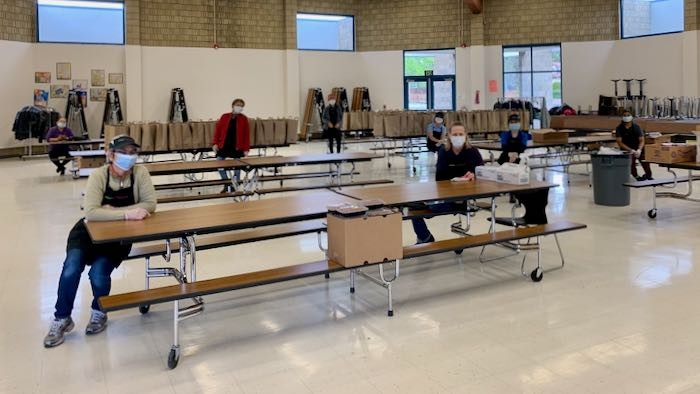With Schools Closed, How Are Kids Getting Fed?

School Food Services Get Creative
Even in normal times, millions of families in California depend on school to help feed their children. In the context of a pandemic, basic food service is more urgent than ever. School food systems are rising to the challenge. How are kids getting fed?
Federal Food
A little background is in order. Feeding children has always been of critical importance for schools, and about 100 years ago PTAs played a critical role in the movement to provide lunch in schools. In 1946 Congress created the National School Lunch Program under the Truman administration, establishing that food for all kids is a matter of national interest. The program operates under the US Department of Agriculture (USDA).
In total, America's federal system of school food service is one of the largest logistical operations on the planet. The delivery system is very decentralized. On tiny budgets of about 3 dollars per meal, each school district is responsible for sourcing healthy ingredients, preparing food and serving it fast, to impinge as little as possible on instructional time.
At most schools, any student can get food at school by paying for it, but in practice most school meals are served for free or at a reduced price based on household income. In schools where a large proportion of families are low-income, new provisions allow cafeterias to skip the bureaucracy and just focus on providing the food.
School systems stretch their purchasing power by sourcing locally when they can, or by buying food commodities through USDA. What actually shows up on the school lunch plate in normal times can vary a lot from place to place, as this visual comparison from the Washington Post makes clear.
The Pandemic: School Meals To Go
The COVID-19 pandemic has required school food services to change everything, fast. With unemployment skyrocketing, the number of families in need is growing fast. Getting food to kids has become a more essential function of schools than ever.
Miguel Villareal, Director of Child Nutrition for San Ramon Valley Unified School District (SRVUSD), is quick to point out that school food service staff is well-trained to handle emergencies. "We're fired up," he said. "We think of ourselves as first responders."
 Miguel Villareal
Miguel VillarealWith school buildings empty, food service staff has had ample room to spread out, commandeering spaces to prepare, package and distribute food while keeping a safe distance. Curb lanes normally used to pick up students have been repurposed. In San Ramon Valley, no-touch curbside meal pick up is now offered two days each week. "We're trying different approaches," said Villareal, "keeping an eye out for strategies to reduce touch points as much as we can."

Federal rules were painfully bureaucratic at the beginning of the crisis. For example, families were only allowed to pick up food for children if the children accompanied them in the car. Happily, USDA waived the requirement swiftly. "Now families can just drive up and say how many meals they need," said Villareal. "That's better and safer. We really miss the chance to interact with the kids, though."
In order to develop best practices in this new reality, Villareal said, Child Nutrition Directors have been "in contact a lot. We work miracles to source good food."
Schools and food banks are separate organizations that provide related services to many of the same families. Unlike school food services, which are government entities with permanent, trained staff, food banks are non-profit organizations that depend on donations of money, materials and volunteer labor. The leaders of these organizations often look for opportunities to collaborate — after all, hunger doesn't end when school is out of session. Especially at a time of crisis, these relationships are a critical asset.
Thinking Beyond the Crisis
California's state funding for school meals is small in comparison to federal funding. Just prior to the pandemic, with California's budget booming, Governor Newsom's budget proposal for 2020-21 included, for the first time, substantial state funding for school meal programs. The proposal, spearheaded by the state's First Partner Jennifer Siebel Newsom, would have boosted school nutrition funding by perhaps 40%, dramatically changing the amount of money available to make school meals healthy and appealing.
The governor's proposal, if eventually enacted, would also change the politics of school meals. At present, states have relatively little influence over school nutrition. Newsom's proposal aims to change that, for example by including a significant farm-to-school grant program to add more produce to the menu.
School food services are usually easy to take for granted. This crisis provides an opportunity to appreciate their importance, and perhaps to imagine a better future.
Thanks to Miguel Villareal and the staff at SRVUSD for photos used in this post.
Tags on this post
Health Purpose of education PandemicAll Tags
A-G requirements Absences Accountability Accreditation Achievement gap Administrators After school Algebra API Arts Assessment At-risk students Attendance Beacon links Bilingual education Bonds Brain Brown Act Budgets Bullying Burbank Business Career Carol Dweck Categorical funds Catholic schools Certification CHAMP Change Character Education Chart Charter schools Civics Class size CMOs Collective bargaining College Common core Community schools Contest Continuous Improvement Cost of education Counselors Creativity Crossword CSBA CTA Dashboard Data Dialogue District boundaries Districts Diversity Drawing DREAM Act Dyslexia EACH Early childhood Economic growth EdPrezi EdSource EdTech Education foundations Effort Election English learners Equity ESSA Ethnic studies Ethnic studies Evaluation rubric Expanded Learning Facilities Fake News Federal Federal policy Funding Gifted Graduation rates Grit Health Help Wanted History Home schools Homeless students Homework Hours of opportunity Humanities Independence Day Indignation Infrastructure Initiatives International Jargon Khan Academy Kindergarten LCAP LCFF Leaderboard Leadership Learning Litigation Lobbyists Local control Local funding Local governance Lottery Magnet schools Map Math Media Mental Health Mindfulness Mindset Myth Myths NAEP National comparisons NCLB Nutrition Pandemic Parcel taxes Parent Engagement Parent Leader Guide Parents peanut butter Pedagogy Pensions personalized Philanthropy PISA Planning Policy Politics population Poverty Preschool Prezi Private schools Prize Project-based learning Prop 13 Prop 98 Property taxes PTA Purpose of education puzzle Quality Race Rating Schools Reading Recruiting teachers Reform Religious education Religious schools Research Retaining teachers Rigor School board School choice School Climate School Closures Science Serrano vs Priest Sex Ed Site Map Sleep Social-emotional learning Song Special ed Spending SPSA Standards Strike STRS Student motivation Student voice Success Suicide Summer Superintendent Suspensions Talent Teacher pay Teacher shortage Teachers Technology Technology in education Template Test scores Tests Time in school Time on task Trump Undocumented Unions Universal education Vaccination Values Vaping Video Volunteering Volunteers Vote Vouchers Winners Year in ReviewSharing is caring!
Password Reset
Search all lesson and blog content here.
Login with Email
We will send your Login Link to your email
address. Click on the link and you will be
logged into Ed100. No more passwords to
remember!














Questions & Comments
To comment or reply, please sign in .